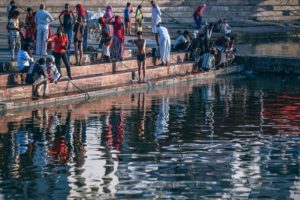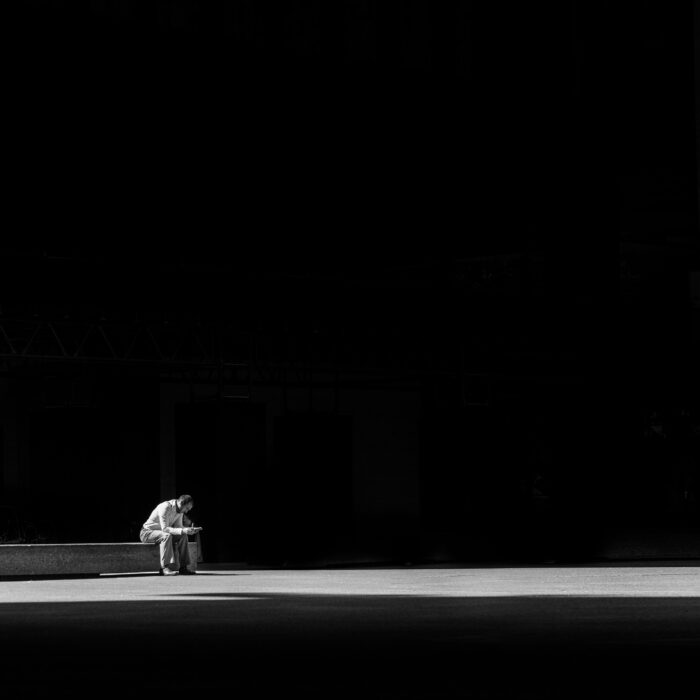You have no items in your cart. Want to get some nice things?
Go shopping The calloused hands of the oarsman worked a rhythmic sluice in the Ganges River. The rising sun cast a pinkish hue through the fog, and smells of incense, spices, and cow dung assailed us. We had hired a boat to take us down the Ganges to watch the most sacred of rituals, the burning of the bodies in Varanasi.
The calloused hands of the oarsman worked a rhythmic sluice in the Ganges River. The rising sun cast a pinkish hue through the fog, and smells of incense, spices, and cow dung assailed us. We had hired a boat to take us down the Ganges to watch the most sacred of rituals, the burning of the bodies in Varanasi.
We walked from the small wooden boat to Manikarnika Ghat, one of the cremation sites to meet our guide. “No photos, here,” he said. Although I saw many other tourists taking pictures, I vowed to capture this only on the screen of my memory. I would not disrupt this holy ritual by taking pictures; wouldn’t distance myself from it by watching it through the lens of a camera.
The guide shooed away beggars and children selling small shells that cradled candles and marigolds – an offering for Mother Ganga. The murky river held a thousand such lights, stars drifting in the dawn waters; the real stars hidden by the tent of clouds.
Three barefoot girls approached us with baskets of candles. A skinny street dog followed them. “A wish for you,” the girls said. Our guide told them to leave, but my friend Sholeh said, “No, it’s OK. I want to buy them.” We each bought two shells. Sholeh wanted to take a picture of the three girls, but they would not stand together. The taller girl, the one with some English, told us that it was because they were Dalits, Untouchables. She belonged to a higher caste. So we took pictures of the two smaller girls together and then one of the taller girl alone. When Sholeh showed them their digital images, they huddled around her, standing on their tip-toes to see, squealing; momentarily forgetting to keep their distance from one another. I handed out chocolates to the children. I made sure to give more to the smaller girls. A bad idea, I realised later, because they might not own toothbrushes.
Sholeh carefully placed her shells on the water’s surface; watched them sail away. I bent down to the Ganges to float my candle, making a wish for the children I had seen in the train station, the small boy holding a sick baby, flies circling and landing on the infant’s crusted eyes. Then I made a second wish for the girls who had sold us the shells, but I dropped them into the water, and they turned upside down, extinguishing the flames.
The sadhus, or holy men, congregated at the river’s edge. They were unmistakable – either naked or in loin cloths with long tangled locks and beards, they covered their bodies with the ash from the cremations, making their mouths and eyes look like black holes. “You are lucky,” our guide told us, “You have come during holy ceremony. Many holy men giving advice.” The sadhus had come for KumbhaMela, a sacred pilgrimage that happens only three times every 12 years, each in a different sacred city. A sadhu is a man who has given up all worldly possessions, living a life of renunciation. He is considered dead both to himself and to the country of India. “They go to live in caves in the mountains. Say goodbye to all life,” our guide explained.
A walking ghost. I had recently divorced my husband, left our life together, and that’s how I had felt at times – aimless and in between. Waiting for something to happen.
One big-bellied sadhu drew a crowd. He was standing on a block above the audience, rolling his ashy penis around a stick. A few videotaped his stunt. “They show that their bodies are unimportant in this way,” the guide explained. “They are attached to nothing.”
I noticed a Western woman, a traveler in the requisite zip-off pants and floppy hat, the tourist uniform I had tried to avoid. She sat with a group of ash-covered Sadhus. They were all smoking something, and she was laughing. I asked Sholeh, “Should we save her?”
“From what?” Sholeh asked.
I couldn’t answer.
My life at home, the one I had called my real life, seemed very far away. It was as if the pathways in my brain navigated different channels, and the world itself shifted, ever so slightly, but enough to feel the tilt. Enough to show me that everything I believed came up for question; showing me an opening where I had believed none existed.
We walked past a dying cow. A blanket draped over the moaning animal, the large brown eyes already filled with flies, as three children tended a nearby fire. Our guide explained that once the cow died, it would be pushed into the river. “Cows, in this country, very sacred,” he said. This sacred cow might have ingested too many plastic bags, painfully blocking its intestines – the sad fate of so many cows in India.
Along with children, pregnant women, and holy men, who are all considered pure, the sacred cows are not cremated but rolled into the river. Everyone else, except those bitten by venomous snakes, are cremated, promising liberation from the endless cycle of life and death, or moksha—an express ticket to heaven. The snake charmers are sent down the river on a bamboo stretcher for purification and then fetched out further down to make sure they are really dead and not just under the spell of the snake. Judging by the number of snake charmers I saw in India, I imagine there are many such stretchers bobbing along the Ganges.
Our guide led us to a narrow path between the burning bodies. The VIPs were burned in a separate area, opting for the more expensive sandalwood for their pyres. Once charred by flame, the bodies all looked alike, all smelled of rosewater, fire, and ash.
Every few minutes, men travelled barefoot down the stairs with another silk-shrouded body on their shoulders. They chanted and the family followed. The oldest son, shaved from heel to head, bathed in the river, and robed in white. It was his job to bring the eternal fire to the body and then to throw the bone fragments into the water, telling his father, “You go your way now, and I’ll go mine,” preventing him from becoming a ghost.
So many ghosts. So little distance between the dead and the living. Watching them felt like an intrusion. The Dalits or Untouchables, the lowest Hindi caste, tended to the “eternal fire,” a 3,500 year old flame that must never die. A Dalit inherited the flame, and now he was a millionaire as the cremations were so expensive. Because the wood must be transported by boat along the Ganges to Varanasi, cremations on the banks of the river don’t come cheap, anywhere from 40,000 rupees according to our guide, which is nearly 900 US dollars, the average per capita income in India. Families save their money, hoping for a cremation at the Varanasi Ghats. The less expensive cremations, though perhaps more environmentally friendly, are done in large concrete crematoriums, the smoke billowing from their distant chimneys.
Varanasi is sometimes called the city of death; there are bodies are everywhere. The dead are carried on bamboo stretchers along the streets, tied to the luggage racks of SUVs. We travelled behind one such car in traffic, and a foot peeked out from underneath the death shroud. I couldn’t help but stare, the hummock of ankle, the white ball of the foot, the curled toes—the bare extremity of a dead person felt like it should have been kept private, like a stranger’s secret overheard in passing.
At the cremation ghats, we walked among the dead, the basket of the hips in one smoldering pile, the curved lower backbone in another. Our guide said, “This one almost finished.” He pointed to a burning pyre. I could almost make out the skull, a flame twisting from the ghost of the eye. Fire ate the saffron cloth, the skin, the flesh. I looked at the other pyres, one held a pelvis, another a skull.
“Three hours,” our guide said, “to burn a body.” My legs burned hot from the flames, and a rain of ash fell into my hair. “Very good luck,” the guide told us, “Good luck indeed.” He pointed to the ash in my hair, the dead caught in my curls.
“Come,” our guide said, and we were led past the cows and goats, who snuffled around in the embers. We passed a stock of wood, and entered a cold concrete building where the elderly waited to die. As we walked past, their murky eyes followed our legs. We held their gaze, and they held ours.
We met an ancient woman with a toothless mouth and a face creased like a wooden totem. She held out her hand, and a wrinkled breast sagged from her sari. She tucked it back in without apology. Our guide explained, “She needs money for her pyre. Good karma for you.” We gave her 500 rupees, about 12 American dollars, a large sum by Indian standards but perhaps not enough to make her deadline. We had wanted to protect our karma, but the guide said, “Not enough. You must give more for your karma.” We shook our heads, wondering what his cut might be.
Still, I worried about my karma.
We walked back down to the shore where the boatman waited. The prayers rang from the mosques; the sun hung pink in the smoky sky.
My eyes burned and I had that feeling—not a feeling that I was about to cry exactly, but a thickening behind my eyes and in my throat, a breathlessness. Not from sadness, but from a tenanted beauty, from a paradoxical landscape where no separation exists between the beautiful and the ugly, the spiritual and the secular, the calm and the chaotic. Wallace Stevens says, “Death is the mother of beauty.” A travel brochure on Varanasi warns: “Varanasi: You will either love it or hate it, but you will never forget it.” Is it not possible to love a place and hate it at the same time?
If nothing else, India will teach you how to hold two contradictory things as truth at once: death and life, loss and love. We floated down the Ganges, and from the river, I looked back toward the burning bodies, the black marks on sand. We drifted through the smells of smoke, the living and the dying and the dead. Children ran above, along the rooftop of the concrete building where an old woman waited to die. The fires below created a hot breeze that lifted their colourful kites and the ring of their laughter into flight.

About Suzanne Roberts
Suzanne Roberts is the author of the award-winning memoir, Almost Somewhere: Twenty-Eight Days on the John Muir Trail, as well as four collections of poetry. She writes and teaches in South Lake Tahoe, California. More information may be found on her website: www.suzanneroberts.net




Beautiful essay.
Wonderful article thanks for sharing with us. Here i have an article by which you will easily learn to open saved password in microsoft edge browser in easy steps without any interruption.